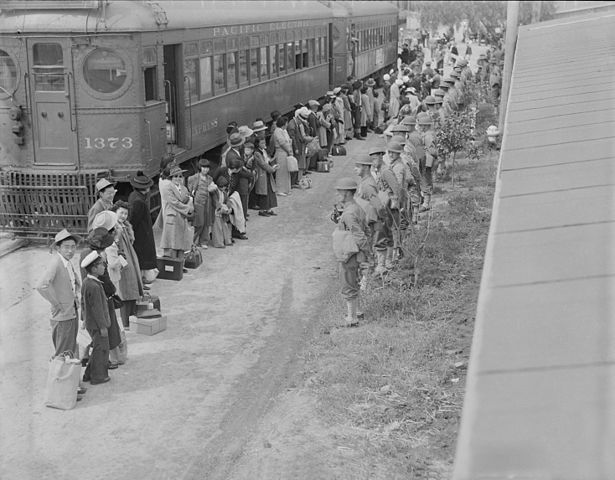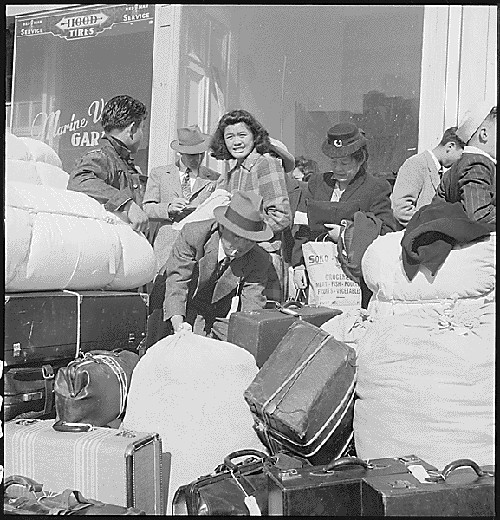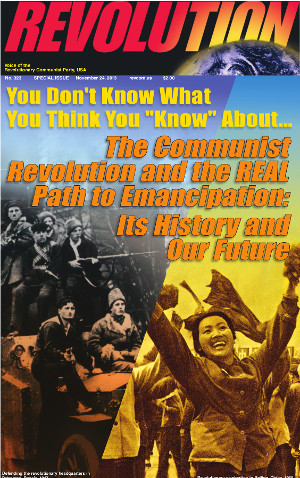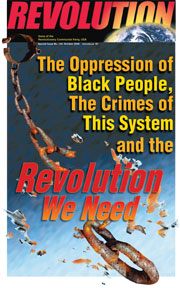Case #89: 120,000 People of Japanese Descent Put in U.S. Concentration Camps During World War 2
Updated February 19, 2021 | Revolution Newspaper | revcom.us
Bob Avakian recently wrote that one of three things that has “to happen in order for there to be real and lasting change for the better: People have to fully confront the actual history of this country and its role in the world up to today, and the terrible consequences of this.” (See “3 Things that have to happen in order for there to be real and lasting change for the better.”)
In that light, and in that spirit, “American Crime” is a regular feature of revcom.us. Each installment will focus on one of the 100 worst crimes committed by the U.S. rulers—out of countless bloody crimes they have carried out against people around the world, from the founding of the U.S. to the present day.
Editors’ note: February 19, 2021 marks the 79th anniversary of Executive Order 9066 signed by U.S. President Franklin Roosevelt, which led to the rounding up and imprisonment in concentration camps of 120,000 people of Japanese descent during World War 2. In this light, we are reposting this piece from the American Crime series.

People of Japanese descent lined up to be taken to the concentration camp at Gila River, Ariz., 1942. (Photo: Clem Albers/National Archives)
THE CRIME: During World War 2, 120,000 people of Japanese descent, nearly the entire Japanese population living in the continental U.S., were rounded up and imprisoned in concentration camps throughout the western states within months of Japan’s December 7, 1941 attack on Pearl Harbor, the U.S. naval base in Hawai‘i. Sixty-two percent of those imprisoned were U.S. citizens; and more than half were children. They were never charged with a crime; never given a hearing; but summarily rounded up and held for more than two years in remote locations, solely on the basis of their nationality.
When people were rounded up, they could only take what they could carry and people were forced to quickly sell almost all of their possessions. Before the war, Japanese Americans farmed 40 percent of the total acreage in California. Their land—as well as $40 million of crops in the ground and over $100 million in investments—was virtually stolen from them when they were forced to sell very cheaply. And because of the evacuation, people lost more than $4 million in businesses—mostly small businesses.
Any resistance was quickly dealt with. When three men, Minoru Yasui in Oregon, Fred Korematsu in California, and Gordon Hirabayashi in Washington state—refused to report for evacuation and insisted the orders were unconstitutional, they were arrested, convicted, and sent to prison. This was later upheld by the U.S. Supreme Court on the basis that the evacuation was based on military necessity.

Some of a group of 664 people of Japanese descent, the first to be removed from San Francisco, April 16, 1942. (Photo: Dorothea Lange/National Archives)
Families found themselves surrounded by soldiers with rifles with bayonets; packed into filthy “assembly centers” where animals had been kept, with no beds. They were put on trains, not knowing where they were going—taken to 10 internment camps in desolate, desert areas. The camps were surrounded by barbed wire with guard towers, and patrolled by soldiers armed with rifles and bayonets. Guards had orders to shoot anyone trying to leave without a pass or refusing orders to halt. After rebellions in some of the camps, “troublemakers” were rounded up and put in one maximum security camp at Tule Lake, where tear gas was used against continuing resistance.
At the same time, over 2,000 people of Japanese descent living in 13 Latin American countries, 80 percent of them from Peru, were taken to Panama, and eventually to the U.S. camps. Five hundred or more of these Latin American prisoners were traded by the U.S. in exchange for prisoners of war (POWs) being held by Japan.
There were an additional 150,000 people of Japanese ancestry living in Hawai‘i —nearly a third of the entire population of the islands. Fearful of the economic and political impact of imprisoning so many professionals, small businesspeople, religious leaders, and agricultural workers, the government imprisoned only 2,000 of them. But all of Hawai'i was placed under martial law for the duration of World War 2.
THE CRIMINALS: President Franklin Roosevelt issued Executive Order 9066 on February 19, 1942, allowing regional military commanders to designate “military areas” from which any or all persons were excluded. One month before Pearl Harbor, Roosevelt received a report saying Japanese in the U.S. did not pose any security danger. But this did not stop the U.S. from using Executive Order 9066 to “exclude all people of Japanese ancestry” from living anywhere on the West Coast—all of California, and large parts of Washington, Oregon, and Arizona.
The FBI was able to act quickly because the Office of Naval Intelligence (ONI) had already compiled lists identifying key community leaders. By 1939, lists of “dangerous” citizens and non-citizens were being compiled by the FBI, special intelligence agencies of the Justice Department, the Office of Naval Intelligence, and the army’s Military Intelligence Division. The U.S. Census Bureau was forced to admit decades later that it had provided information on people living in the U.S. of Japanese ancestry
This enabled the FBI to arrest more than 1,200 Japanese immigrant men within hours of the Pearl Harbor attack—targeted as “potential threats to national security.” These were in fact community leaders, Buddhist priests, Japanese language teachers, and others who might be able to mobilize an outcry and political resistance to these roundups.
Major U.S. newspapers played a crucial role in creating the conditions and setting the stage for targeting U.S. citizens and children as well as immigrants by whipping up ugly, racist attacks on anyone of Japanese descent. The Los Angeles Times ran the following:
A viper is nonetheless a viper wherever the egg is hatched. So, a Japanese American born of Japanese parents, nurtured upon Japanese traditions, living in a transplanted Japanese atmosphere... grows up to be a Japanese, and not an American... Thus, while it might cause injustice to a few to treat them all as potential enemies, I cannot escape the conclusions... that such treatment... should be accorded to each and all of them while we are at war with their race.
THE ALIBI: The excuse for these crimes against humanity was the alleged “danger” to the country posed by these “enemy aliens.” The military’s reach included everyone who was at least one-sixteenth “Japanese”—the equivalent of having one Japanese great grandparent. And this was done despite the conclusion based on numerous military, FBI, and CIA investigations of the Japanese population in the U.S. conducted before and after Pearl Harbor—that the “Japanese problem” was non-existent.
THE ACTUAL MOTIVE: This massive crime against a whole people inside the U.S., with ominous implications, played an important role in cohering the country around the “necessity” to support a war of worldwide slaughter—including the massive U.S. war crimes committed against hundreds of thousands of Japanese civilians when the U.S. dropped atomic bombs on Hiroshima and Nagasaki. For those who rule this country, World War 2 was waged in the interests of U.S. capitalism-imperialism—to defend and expand its control and domination of whole areas of the world, including Asia, Southeast Asia, North Africa, and more against their imperialist rivals—Germany, Italy, and Japan.
REPEAT OFFENDERS: Long before the Japanese internment, the U.S. forced all the surviving Native American tribes into concentration camps—called “reservations.” This was the final stage in the genocidal destruction of the great majority of Native Americans, who had once numbered in the millions on the continent, and the theft of their lands across the country in the name of “Manifest Destiny.” The survivors were forced to find a way to survive and make a living in some of the most desolate parts of the country.
When it came time to find places to imprison over 100,000 Japanese descendants, the great majority were relocated to Native American reservations in the most remote, desolate areas of seven Western states.
Today the same racist justifications used against people of Japanese descent in the U.S. are being put out against immigrants from Mexico, Central and Latin America, and against any Muslims. Donald Trump and other major fascists are whipping up people with the same kind of arguments used to justify the American Crime of U.S. concentration camps during World War 2. This includes the rise of racist hatred and violent attacks, even murder, against people of Asian descent across the U.S.
Volunteers Needed... for revcom.us and Revolution
If you like this article, subscribe, donate to and sustain Revolution newspaper.









